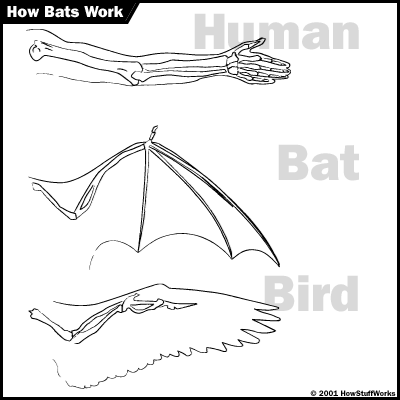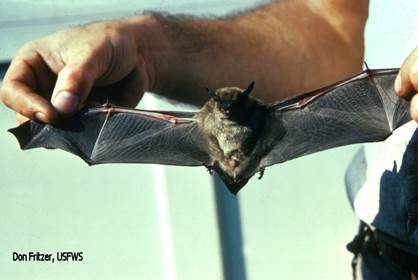Twinkle Twinkle little bat. How I wonder what you’re at! Up above the world you fly, like a tea-tray in the sky. The Mad Hatter, Lewis Carroll
Myotis – from the Greek mys for mouse and otus for ear; and lucifugus – flee from the light.
The little brown bat is found throughout most of North America extending through southern Alaska, and most of Canada. Its range does not extend into the southern extend of the US and Mexico. This is a small uniformly dark brown bat with slightly paler gray fur underneath. The wingspan is about 8.7-10.6 inches with a body from 2.4 – 3.9 inches long and they weigh a mere 0.2 – 0.5 ounces – so about the same as 25 paper clips.
They can be distinguished from the similar looking (and endangered) Indiana myotis because they lack a keel on their caclar and the long hairs on their feet extend beyond their toes. The calcar is the edge of the membrane connecting the foot to the tail. Another often used identification characteristic in bats is the presence or absence of a sagittal crest, or ridge on the skull. So you have to give them a pet on the top of the head to see if they have this or not. LBBs do not have a crest.
A bat’s wings are supported by what are analogous to our fingers, with the “thumb” extending out as a small claw used to grab with.


LBBs use three different roost sites – day, night, and hibernation roosts. Day and night roosts are used during the spring through fall, while hibernacula are used in winter. Day roots can be a wide range of sites – under tree bark, siding of houses, or in wood piles. Bats rest in night roosts following feeding in the evening – some speculate that this keeps their feces away from the day roosts, which might be noticeable to potential predators.
LBBs will generally hibernate in caves and unused mines. In WA and OR the hibernation period generally begins in September and extends through mid-May. In some areas they are known to come out of torpor if temperatures rise above 50° and hunt emerging insects. They are thought to migrate less than 100 miles to reach suitable hibernacula.
Here’s s short video of one crawling about: https://www.youtube.com/watch?v=AxExwByOb9c
LBBs will prey upon a variety of insects including moths, gnats, mosquitoes, midges, mayflies and others. Because many of their prey items have an aquatic stage, LBBs will tend to roost near open water. Another reason they roost close to water is their inability to efficiently regulate their urine concentration and the need to drink. They find their prey using echolocation – emitting high frequency calls (200 per second) and capturing prey with their wing or tail membranes and quickly transferring the food item to their mouth while in flight. They also are known to simply pick insects off vegetation and off the water surface.
The echolocation sounds are at a frequency above the range of human hearing, but using bat sound recorders and analysis software you can figure out what bats are flying around your belfry. As the summer dusk fell over the ball field when a kid in suburban N.J., we would entertain ourselves as the bats foraged above us by tossing small pebbles as high as we could and watching the bats dive after them, veering off when they realized it was not an insect.
LBBs are promiscuous and males will inseminate females that are active or torpid. The females will delay ovulation and store the sperm for about seven months between copulation in the fall and fertilization in the spring. Pups are born in June and July. Lactation is a huge energy demand on these small mammals and only one young is born per year. Normally bats hang upside down when roosting but females will reverse their position and the young are born into the interfemoral (between tail and leg) membrane. After nine days the pup is able to thermoregulate and can fly within three weeks.
They are independent in around four weeks. After weaning it’s not clear if the mother teaches the pup how to hunt or starts things off by bringing them insects. The usual life span of LBBs is about 10 years but banded ones in the wild have been recorded to live up to 31 years – quite the feat for such a small mammal.
Predators include owls, mice, weasels, hawks, snakes, raccoons, and domestic cats. I once saw a sharp-shinned hawk swoop across a meadow to pick a red bat (another small species) out of the air.
A couple of my friends were studying bats in graduate school so I (got) volunteered to assist and a number of caving trips and late night forays. On a dozen or so occasions we traipsed into to a cave entrance near dusk, waited, had a beer or two until the evening fly out of the cave had taken place, and then set up a mist net (very fine netting) in front of the cave to catch the returning bats.
We were mainly looking for Indiana bats but LBBs were very common. We would take data – measure, weigh, and tag them and then let them go on their way. They are so tiny that most of the time we did not wear gloves because it was easier to handle them and their cute little teeth could not even pierce your finger skin.
Contrary to popular opinion, very few bats are infected with rabies. Tapeworms, fleas, mites, and bed bugs are more common. I’d be more worried about a cat bite. So next time you’re taking a summer walk around Green Lake keep an eye out for this small creature – they’re doing you a favor by sucking up all those pesky mosquitos.
